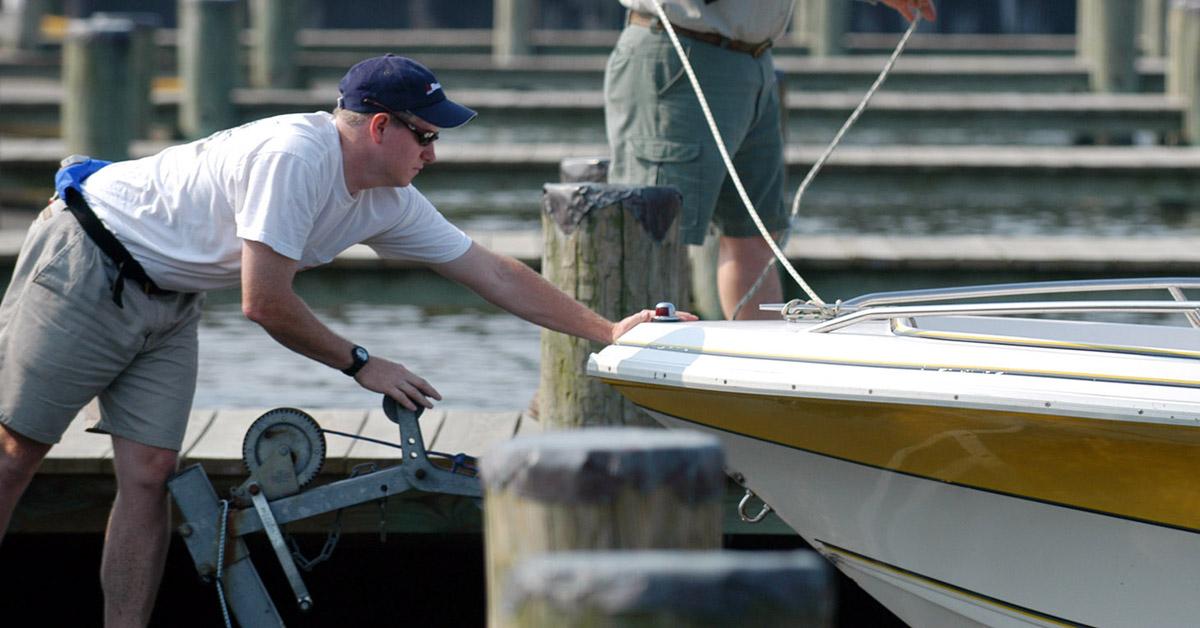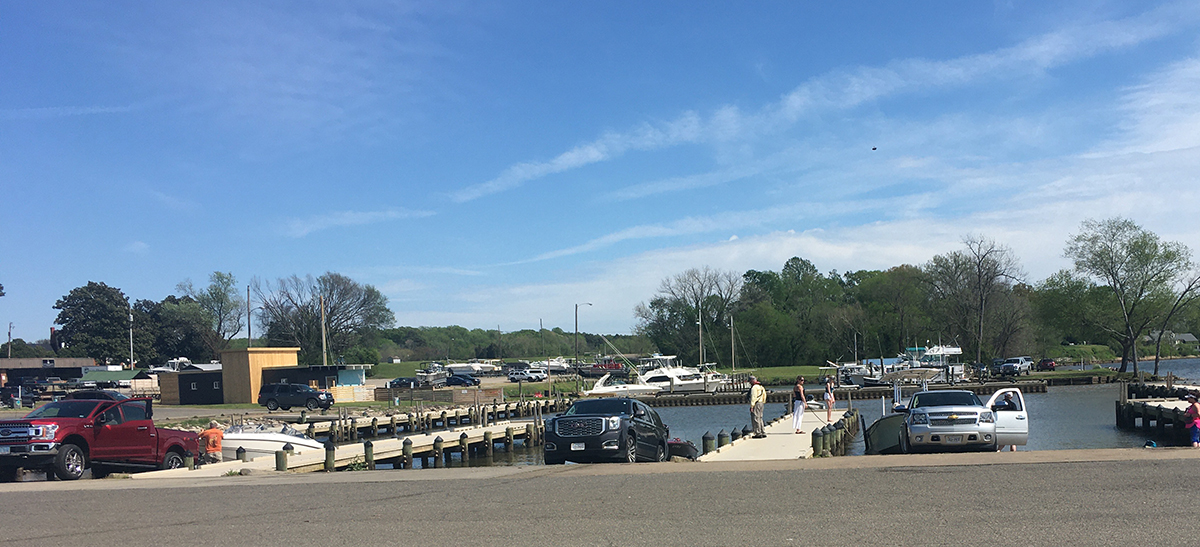
Safety is as important while trailering and launching as when underway on the water here is a checklist for your convenience.
By John Page Williams
If you keep your boat on land, you’re going to have to trailer it to the water to go boating and then launch it. Keeping safety in mind during trailering and launching is just as important as it is while underway! The below checklist is full of simple, common-sense procedures. Follow it carefully and go boating on Virginia’s waters often. Pay attention and it’ll become a comfortable routine.
If you’re new to backing a trailer, don’t practice on a busy boat ramp. Take your boat to an empty parking lot and practice until you can place the rig within the white lines. Though counter-intuitive at first, it’s not rocket science. Boat trailers are actually easier to back than utility or rental trailers because they are longer and don’t jackknife as quickly. Just take your time, pack some patience, and practice. You’ll get a feel for the process.
Consider buying trailer roadside insurance if you don’t already have it. It’s not expensive and can usually be added as a rider to your boat insurance or your annual dues to a national boating organization like BoatU.S. or Sea Tow. It can make an otherwise frustrating day much easier and safer.
At Home:
- It the hitch isn’t already in your vehicle’s receiver, check to make sure the ball is bolted on tight and insert the barrel into the receiver. Slide in the pin and slip on its spring retainer. Make sure the retainer is firmly seated.
- Back your tow vehicle up to the trailer. The easiest way to line up the two is to have someone outside at the trailer tongue direct you.
- If you’re hitching up alone and your vehicle has a back-up camera, spend some time learning how to use it to position the hitch ball precisely under the trailer tongue’s coupler. There are aftermarket cameras available for purchase. An alternative is a pair of tall alignment rods with highly visible balls at the tops and magnets at the bases. Attach one to the hitch and the other to coupler. Back up carefully, watching in your rearview mirror, until they line up and nearly touch. Again, take your time. You’ll learn.
- Crank the tongue jack to lower the coupler onto the ball. Close the coupler’s latch, lock it, and fasten the safety pin. Feel under the coupler to make sure it’s firmly holding the ball.
- Cross the trailer’s safety chains below coupler and connect one on each side of the hitch.
- Connect the wiring for the trailer’s lights.
- Crank up the tongue jack, rotate it to horizontal, and lock it.
- Check that the cable from winch to boat is tight and locked.
- Connect safety chain from winch to boat (if it isn’t already).
- Walk around and check the trailer tires’ pressure and condition. How about the pressure in the trailer’s spare tire?
- Turn on the tow vehicle’s running lights and safety flashers. Check that all the trailer’s lights are working. Turn the lights in the vehicle back off.
- Check the tie-down straps from the boat to the trailer.
- Make sure the tow vehicle has a jack, wheel chocks, and a tire lug wrench aboard.
On the Road:
- After every hour of towing, stop, get out, and walk around the trailer to make sure everything in the boat is secure. Feel the wheel bearings (are they cool?) and visually inspect the tires. Check to see if they, too, are relatively cool (even on a hot day, they should be if they are properly inflated). If you spot a problem, call for roadside assistance.
Practice Ramp Etiquette:
- Park in the ramp’s lot, not at the top of the ramp, to get everything ready.
- Move stuff like coolers, water toys, fishing gear, extra clothes, and first aid kit from the tow vehicle to the boat. Stow everything securely. If you and your passengers need to use the facilities, go now (not when the boat is at the bottom of the ramp and others in line are waiting).
- Disconnect the gunwale or transom tie-downs. Make sure the winch strap and the safety chain are still hooked to the bow eye. (Letting the boat slide off the trailer unintentionally while you’re backing down the boat ramp can ruin your whole day.)
- Install the drain plug. Remove the transom saver if you use one. Turn on the battery switch and unlock the engine’s manual tilt lock. Put the key into the ignition.
- If the ramp is crowded, get in line. Don’t move the boat down the ramp until it clear of other users.

Make sure to wait for a boat ramp to clear before backing down it.
The Launch:
- Position the trailer at the top of the ramp and slowly back down. You may find it useful to keep a pair of waterproof knee boots in your kit for the launch.
- If you’re launching into a river with current, think about which way it will push the boat and plan your docklines to keep the boat under control when it floats off the trailer. You might consider hanging fenders on the side of the boat that will lie against the dock.
- Once you’ve reached the water level where the boat can be launched, put your tow vehicle in park and set the parking brake. If the ramp is steep, consider placing chocks under the tow vehicle’s front tires.
- Toss the bow and stern docklines to your crew on the dock. Have them tie the lines to the dock temporarily or hold them securely. If you are alone, tie at least a bow line to the dock before proceeding.
- Remove the winch strap and safety chain from the bow eye. Push the boat into the water and move it to the end of the dock or the opposite side to clear the ramp for the next rig.
- Pick up the wheel chocks and release the parking brake. Drive the tow vehicle and empty trailer up the ramp. Park in a designated trailer area.
- Have everyone in your party put on a Personal Floatation Device (PFD). If you set fenders while launching, bring them in and stow them. Go have a great day on Virginia’s waters!
Going Home:
- Reverse the process above, being careful to dock safely and courteously. Tilt the engine.
- When your turn comes, pull your boat as far onto the trailer as possible and tie off the bow line to the winch post. Connect the winch strap to the bow eye, crank the boat up to the bow stop, and secure it with winch locked and safety chain connected to the bow eye.
- Pull up into the ramp’s parking lot before unloading gear into the tow vehicle. Connect the gunwale or transom tie-downs. Follow all of the securing procedures like turning off the battery switch.
- Once everything is secure, have a safe, smooth ride home. Park the rig, lower the jack stand, disconnect everything, and raise the tongue far enough that the boat will drain. Remove the drain plug.
Also see the Spring Checklist for Boaters for more on making sure your boat is ready for getting out on the water!
John Page Williams is a noted writer, angler, educator, naturalist, and conservationist. In more than 40 years at the Chesapeake Bay Foundation, Virginia native John Page championed the Bay’s causes and educated countless people about its history and biology.


